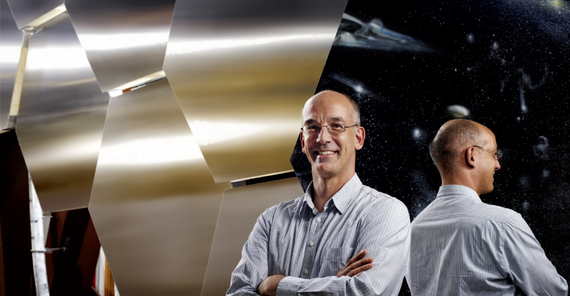There is one appointment after the other. Christian Stegmann hurries down the corridor, a hard hat under his arm. There is a lot of construction work on the campus. Stegmann is head of the German research center Deutsches Elektronen-Synchrotron (DESY) in Zeuthen. Speed is part of the program here: accelerators and telescopes are used at DESY to explore the fundamental components and forces of the universe.
When Christian Stegmann talks about his work, he switches from a concentrated manager to a passionate scientist very quickly. His subject is physics of cosmic rays, the stream of ultra high energy particles that comes from outer space and constantly penetrates the atmosphere of the Earth and all living organisms on it. Stegmann and his colleagues are interested in identifying the sources of this radiation and how nature manages to accelerate the cosmic particles to such an enormous energies as would never be possible on Earth. Stegmann deals with these questions not only at DESY in Zeuthen, but now also at the University of Potsdam, where he holds a professorship for particle and astroparticle physics and where he is establishing a research group. A small team of scientists and PhD students will be working with the data of highly sensitive gamma-ray telescopes. “In the search for accelerators, we have witnessed a revolution over the past ten years,” Christian Stegmann says enthusiastically about the new findings. These findings were mainly obtained with the help of the H.E.S.S. gamma-ray experiment in Namibia. The internationally-operated system of telescopes was named after the physicist Victor Hess who discovered cosmic rays 100 years ago and received the Nobel Prize in Physics for it. It has identified 60 new gamma-ray sources so far. Shock waves of huge stellar explosions are among these sources as well as magnetic and electric fields of pulsars. Driving forces are also in the vicinity of black holes in the cores of active galaxies.
“We have opened a new window to the universe with these gamma-ray telescopes,” Stegmann says, who has been the spokesman of the H.E.S.S. experiment since this year and thus is somehow like the primus inter pares. H.E.S.S. is operated by about 200 scientists from 27 institutions worldwide. Stegmann is fascinated by kick-starting big things. His institute, for example, has designed and constructed the prototype of the enormous reflecting telescopes for the Cherenkov Telescope Array (CTA). This new kind of observatory will be searching for cosmic accelerators in the Northern and Southern hemisphere with more than 50 individual telescopes and with an unprecedented sensitivity. CTA will be able to capture and record more than 1,000 sources.
“For students at the university it is most interesting to be able to get access to such thrilling fields of research and international projects due to our cooperation,” Stegmann says and also announces that young scientists of DESY will give seminars at the university in the near future. It is important to inspire the young academics, “to spark the flame”. He himself was actively involved in teaching as a professor at the University of Erlangen-Nürnberg for many years. At present, he is supervising four PhD students, and the first student of physics from Potsdam started to work as a scientific assistant at DESY recently. Stegmann thinks that the cooperation with the university is a “good strategic decision” and is looking forward to common projects. “The Institute of Physics and Astronomy at the university and the Institute for Astrophysics make Potsdam a center of astro physics.”
Pearls of Science
Each of these research institutes is unique. Together they want to make better use of their potential. Eighteen leading scientific institutes in Brandenburg followed the University of Potsdam’s initiative in 2009 and joined forces within “pearls • Potsdam Research Network”. They want to use synergies dovetailing research and education even more closely. Furthermore, they want to raise third-party funds more successfully and develop fields of research geared to the future.
Text: Antje Horn-Conrad, Online editing: Agnes Bressa, Translator: Voigt

